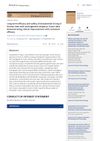Search
for
Sort by
Research
690-720 / 1000+ resultsresearch Figure 8, The Hamilton-Norwood Classification of Male Androgenetic Alopecia
research An Overview on Congenital Alopecia in Domestic Animals
Congenital alopecia in domestic animals is rare and involves abnormal hair follicle development, needing better understanding and classification.

research Platelet-Rich Plasma Injection Is Effective and Safe for the Treatment of Alopecia
Injecting platelet-rich plasma is a safe and effective way to treat hair loss.

research Familial Androgenetic Alopecia in Siblings with Normal Endocrinological Status
Two young siblings experienced hair loss without hormone issues or other skin problems.

research Is There a Relationship Between Androgenic Alopecia and Benign Prostatic Hyperplasia?
There's no link between hair loss type androgenic alopecia and benign prostatic hyperplasia, but early hair loss and family history can mean more severe alopecia.

research Androgenic Alopecia in Women: An Indian Perspective
Androgenic alopecia (AA) in Indian women is rarely reported, with varying severity and patterns, and hair pull tests and trichograms help understand it better.

research LO-010 Relationship Between The EULAR/ACR Classification Criteria And Organ Damage In Systemic Lupus Erythematosus
Higher EULAR/ACR scores in SLE patients predict more organ damage.

research Diagnostic and Grading Criteria for Androgenetic Alopecia Using Dermoscopy
New dermoscopic criteria accurately diagnose and grade the severity of hair loss in androgenetic alopecia.

research Long-Term Efficacy and Safety of Dutasteride 0.5 mg in Korean Men with Androgenetic Alopecia: 5-Year Data Demonstrating Clinical Improvement with Sustained Efficacy
Dutasteride 0.5 mg is safe and effective for long-term use in Korean men with hair loss.

research Long-Term Efficacy and Safety of Dutasteride in Korean Men With Androgenetic Alopecia: 5-Year Follow-Up Data
Dutasteride is safe and effective long-term for male hair loss.

research An Overview of Risk Factors for Androgenetic Alopecia Among Women at Pasar Ambacang, Kuranji, Padang
Older, overweight women with children and a family history of hair loss are more likely to experience female pattern hair loss.

research Androgenetic Alopecia in Women
Hair loss in women, often not related to male hormones, increases with age and can cause significant emotional distress.

research Androgenetic Alopecia: Clinical Features, Classification, and Treatments
Male pattern hair loss is genetic and influenced by hormones, with treatments like minoxidil and surgery available.

research Androgenetic Alopecia and Insulin Resistance in Young Men
Hair loss in young men linked to higher risk of insulin resistance and metabolic issues.

research Eleven Pairs of Japanese Male Twins Suggest the Role of Epigenetic Differences in Androgenetic Alopecia
Epigenetic differences affect hair loss in identical Japanese male twins.

research A Review on Androgenic Alopecia: Etiology, Pathogenesis, Pharmacological and Non-Pharmacological Treatment Approaches
Androgenic alopecia causes hair thinning, and treatments include minoxidil, finasteride, and light therapy.

research A Machine Learning Algorithm Applied to Trichoscopy for Androgenic Alopecia Staging and Severity Assessment
The machine learning model effectively assesses the severity of hair loss and could help dermatologists with treatment decisions.

research Low-Molecular-Weight Synthetic Antioxidants: Classification, Pharmacological Profile, Effectiveness, and Trends
Synthetic antioxidants are effective, cheap, and stable, with some like zinc and cholecalciferol reducing child and cancer deaths, but the safety of additives like BHA, BHT, TBHQ, and PEG needs more research.

research The Cohen Hair Loss Classification System
Dr. Bernard Cohen created a new system to classify hair loss using numbers and a detailed scalp map.
research One Year Cross-Sectional Study of Association Between Androgenetic Alopecia and Benign Prostatic Hyperplasia in a Tertiary Care Hospital
There is no link between hair loss and prostate enlargement.
research Specificity of Anti-SSB as a Diagnostic Marker for the Classification of Systemic Lupus Erythematosus
Anti-SSB antibodies are useful for diagnosing systemic lupus erythematosus and are linked to specific symptoms.

research Zinc Deficiency and Its Management in the Pediatric Population: A Literature Review and Proposed Etiologic Classification
Zinc deficiency in children can cause skin issues and can be serious if not diagnosed and treated properly.

research Telogen Effluvium: Is There a Need for a New Classification
The paper suggests improving diagnosis and treatment of telogen effluvium but does not recommend a new classification system.

research Dissecting Folliculitis (Dissecting Cellulitis) of the Scalp: A 66-Patient Case Series and Proposal of Classification
Researchers found that dissecting folliculitis of the scalp is linked to obesity, severity increases with duration and number of nodules, and early treatment is important to prevent scarring.
research Diagnosis and Management of Primary Cicatricial Alopecia: Part I
The article explains how to diagnose and manage certain types of scarring hair loss.
research Comparative Efficacy of Topical Anthralin and Intralesional Triamcinolone in the Treatment of Alopecia Areata
Triamcinolone regrows hair better but relapses more than anthralin.

research The Dermatological Spectrum of Coronavirus Disease-19: Cutaneous Signs for Diagnostics and Prognosis and an Expanded Classification
Skin problems like rashes and hair loss can help diagnose and predict COVID-19.

research Comparative Effectiveness of Finasteride vs Serenoa Repens in Male Androgenetic Alopecia: A Two-Year Study
Finasteride works better than Serenoa repens for male hair loss.

research Acute Diffuse and Total Alopecia of the Female Scalp: A New Subtype of Diffuse Alopecia Areata That Has a Favorable Prognosis – A Reply
The condition called 'acute diffuse and total alopecia of the female scalp' is actually a known condition named alopecia areata incognita.